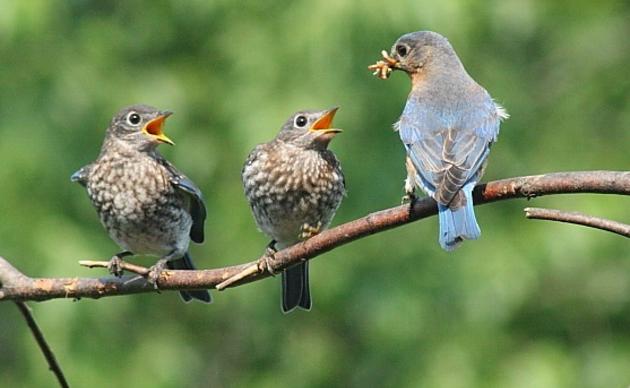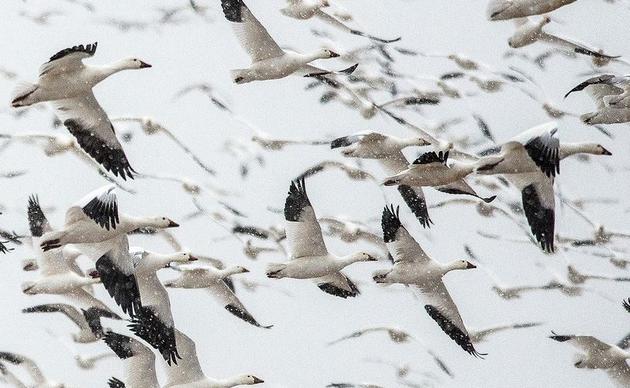Original story published by the Rochester Democrat and Chronicle, by Victoria E. Freile
May 3, 2016
Each spring, millions of birds migrate through Monroe County.
Among them: Tens of thousands of raptors, including an average of 50,000 hawks, that fly northward between March and May.
"We're only one lane of the highway," said Ryan MacLean, the official hawk counter at Braddock Bay. "There are many other hawk watches on Lake Ontario. We only get one batch of birds here, so its hard to imagine how many more we are missing."
The southern shore of Lake Ontario is a hot spot and migration funnel, MacLean explained as the lake shore is en route to breeding grounds in Canada.
Some birds pass by without a second glance while others stop upon spotting the great lake. They pause, often for a night, to roost or to hunt and fuel up.
Hundreds of people last week flocked to Braddock Bay's hawk watch platform, binoculars in hand. MacLean fielded questions from visitors as he completed his daily task— counting each passing hawk. On an average day, he views several thousand hawks above Braddock Bay.
"I see one red-tail, four sharp-shins and four broad-wings up there," McLean said as he pointed skyward, holding his trusted binoculars to his eyes with his left hand. MacLean clicked a hand monitor to account for each hawk as the majestic bird of prey flew far overhead.
"As hawk watchers, we've trained ourselves over the years to look for specific shapes," he said. But since the migrating birds are determined to cross Lake Ontario, MacLean said he knows to look for northbound raptors, their flight patterns and behavior.
But why should the birds be monitored? Data collected annually for the last three decades is sent to the Hawk Migration Association of North America to see how climate change is affecting the migration process, he said.
"Raptors are an environmental barometer," said Daena Ford, president of Braddock Bay Raptor Research. "At the top of the food chain, they double as a monitor. Their presence in an ecosystem gives an idea of the balance within that ecosystem."
Eyes in the sky
Mike Savoy, 48, of Riga tries to visit Braddock Bay Park at least twice weekly each spring.
"It's great to see these beautiful creatures in their environment," said Savoy, who alongside his wife, has been birding for about three years. "We love nature, seeing the ocean and we love animals. We're learning a lot from others, but are totally novices when it comes to seeing these specks in the sky."
Savoy said he's guided by knowledge from those involved with Braddock Bay Raptor Research, a volunteer organization that is celebrating its 30th anniversary. The nonprofit group holds Bird of Prey Days in the park each spring, a weekend-long event that draws hundreds of bird-lovers of all ages. The event was held at the park last weekend.
"Our goal is to get people out and connected with birds in nature," Ford said. "It's important to know why (birds) are coming here and why it's important."
The park also has a raptor-banding station that's operational from March to May. There, licensed banders capture and release raptors, including hawks and owls. During a brief captivity period, each bird is fitted with an aluminum band containing an identification number. Data is also collected from each bird for the Federal Bird Banding Laboratory in Maryland.
In 2015, nearly 200 raptors were banded at the park. More than half of those birds were sharp-shinned hawks. Anyone can stop by and walk nearby trails or watch the bander in action. But be warned, banders do not have set hours.
"Raptors have a big draw," Ford said. "Birds of prey have this mystique, being large birds and birds of power and majesty."
Rochester is in an area that's "a mecca for the spring migration," said June Summers, president of the Genesee Valley Audubon Society. Each bird that passes through is a beautiful, unique individual, she said.
Millions of birds pass through Rochester annually, among them more than 50,000 raptors pass over Braddock Bay while headed north to breed in Canada.
The group hosts educational programs and outings to help area residents "develop an awareness of the outdoors," Summers said. "There's so much going on that people don't know about, particularly in downtown Rochester."
Examples: Swallows, herons and a soft shell turtle that all live near the Genesee River. There are also two adult Peregrine Falcons who live in a nest box atop the Times Square Building at Broad and Exchange. You can watch the bids' nest online at rfalconcam.com. The female falcon, Beauty, is currently sitting on four eggsexpected to hatch any day. Since 2010, 36 offspring were raised in the downtown nest.
"We love to show people that despite being in a concrete canopy, there's so much life," Summers said. "You learn an understanding of the relationship between the male and female birds and how they interact as a family unit."
Viewers also watch how the adult falcons interact with their young. "When they see it, people are amazed at what these birds can do," she said.
Out in nature
"Once you see it you'll never forget," said Laura Kammermeier, president of theRochester Birding Association, a local birdwatching group that educates others about where to find birds in the Rochester region. "All it takes is for someone to teach you or show you about birding. Once you see an owl coming out of the woods, or a warbler, your eyes just pop."
The all-volunteer group offers weekly free hikes to birding hotspots around the area and monthly seminars on birds and related topics.
"You can be a skeptic, but once you try it, it's amazing," she said.
Also coming up this spring are a variety of events at the Montezuma Audubon Center, a 198-acre parcel in Wayne County operated through the state Department of Environmental Conservation and the National Audubon Society. Part of a larger 50,000-acre Montezuma Wetlands Complex, the area is a migratory stopover for waterfowl, including millions of ducks, geese and swans, said Audubon Center Director Chris Lajewski.
The Center will hold its annual wildlife festival on Saturday, May 7. As always, the stars of the festival will be live animals brought in for the day, Lajewski said, but other activities include guided birdwatching hikes and canoeing trips on property at the event.
As waterfowl and songbirds migrate each spring and fall, Montezuma acts as the first major resting point north of the Chesapeake and Delaware Bay areas.
"Just like humans, birds need to refuel and rest in a long journey," he said, noting that the birds found in the complex are headed to parts of New York and Canada, some as far north as the Arctic tundra, so they can breed. "Without refuge, there would be far fewer birds in the world."
Upcoming birding events
Warbler hot spots: Learn the basics of identifying warblers along the lake shore during a Beginner Field Trip on Saturday, April 30. The group will meet in the lot behind Lakeview Community Church, 30 Long Pond Road., Greece at 7:30 a.m. The free outing, led by the Rochester Birding Association, is geared toward novice birders and will teach attendees identification skills, about habitats will answer birding questions. Bring binoculars if you have them and wear boots. rochesterbirding.com
Birding field trips: A variety of free birding field trips at popular birding spots in the region are scheduled as follows: Cobbs Hill Park in Rochester at 8 a.m. on Wednesday, May 4 (meet by the woods at the top of the reservoir for a trip into Washington Grove); Thousand Acre Swamp at 7:30 a.m. on Thursday, May 5 (meet at the park entrance off Jackson Road); Island Cottage at 7:30 a.m. on Sunday, May 8 (Meet at Island Cottage parking lot at Island Cottage Road and Edgemere Drive.) rochesterbirding.com.
Wildlife Festival: The 10th annual Wildlife Festival will run from 10 a.m to 3 p.m. on Saturday, May 7 at the Montezuma Audubon Center, 2295 State Route 89, Savannah. Wayne County. The family-friendly event includes live animal presentations, birdwatching hikes, canoeing and kayaking trips, children's games and activities and more. Entry is $5 per adult or $3 for children 5 and older. Children under 5 are free. ny.audubon.org. (315) 365-3588.
Walk in Mt. Hope Cemetery: The Genesee Valley Audubon Society will lead a bird-watching field trip in Mt. Hope Cemetery on Sunday, May 15. The group will meet at the cemetery's North Gate at 8 a.m. for a two-hour walk. Fee is $7 per person.gvaudubon.org. For more details call (585) 865-6047.



